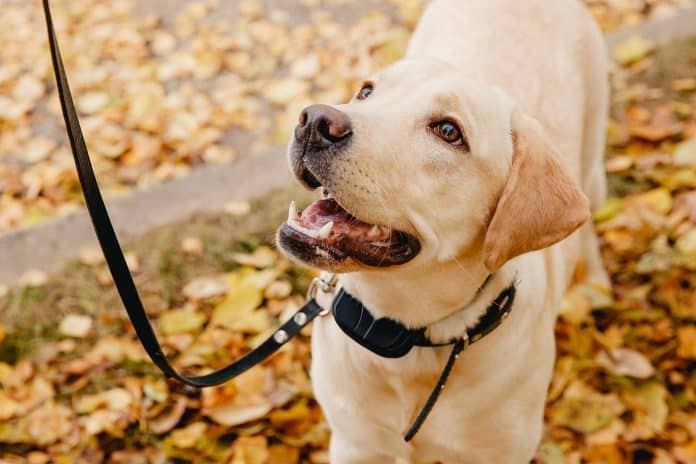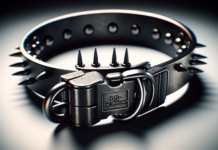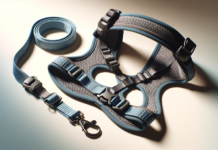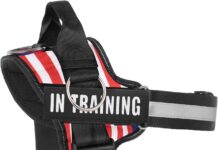In this article, we explore various training techniques that are highly effective when used in combination with training collars.
We dive into the dog training world, seeking gentle yet efficient methods that can be incorporated alongside these collars to ensure optimal learning and behavior modification for our furry friends.
Whether you’re a seasoned dog owner or a novice, this article aims to provide a well-rounded understanding of the most successful training techniques that complement training collars.
Positive Reinforcement Techniques
Clicker Training
Clicker training is a highly effective positive reinforcement technique that utilizes a small handheld device known as a clicker. This technique involves associating the clicker’s sound with a reward, usually a treat, to communicate to the dog that they have performed the desired behavior correctly. The clicker serves as a precise marker of the specific behavior being reinforced. By using the clicker consistently and following up with a reward, we can effectively communicate to our dogs which behaviors are desirable and reinforce their good behavior.
Treat-Based Training
Treat-based training is a popular and practical positive reinforcement technique that involves using treats as rewards to encourage desired behaviors. This technique relies on the dog’s instinct to seek out and respond to food rewards.
By offering treats as a reward for performing the desired behavior, we can motivate our dogs to repeat that behavior in the future. Choosing appropriate treats that are both enticing and healthy for our furry friends is essential.
Verbal Praise
Verbal praise is a simple yet powerful positive reinforcement technique. Dogs are highly responsive to the tone and enthusiasm in our voices, and using cheerful and affectionate words can effectively reinforce their good behavior.
Offering words of encouragement, such as “good job” or “well done,” in a cheerful and enthusiastic tone can significantly impact our dogs’ motivation and willingness to learn. Verbal praise works particularly well when combined with other forms of positive reinforcement, such as treats or clicker training.
Negative Reinforcement Techniques
Leash Corrections
Leash corrections involve using slight tug or pressure on the leash to communicate to the dog that they are not behaving correctly. This technique should be used sparingly and with caution to avoid causing discomfort or pain to the dog.
It is essential to ensure that the leash correction is applied at the right moment and with the proper force to redirect the dog’s behavior effectively. Positive reinforcement should always follow leash corrections to reward the desired behavior.
Short Leash Training
Short leash training involves keeping the leash short to maintain close control over the dog’s movements and prevent unwanted behaviors. This technique is beneficial when training dogs to walk politely on a leash or to discourage jumping or pulling.
By keeping the leash short, we can easily guide and redirect the dog’s behavior, making it easier to reinforce the desired behaviors. However, it is essential to ensure that the dog is comfortable and not feeling restricted or stressed by the short leash.
Preset Levels of Stimulation
Preset levels of stimulation are often used in conjunction with training collars, also known as e-collars or shock collars. These collars deliver stimulation, ranging from a mild vibration to a low-level electric shock, to interrupt unwanted behaviors.
The levels of stimulation are preset based on the dog’s sensitivity and the desired level of correction or distraction. It is crucial to use training collars responsibly and under a professional trainer’s guidance to ensure the dog’s safety and well-being.
Combination Techniques
Positive Reinforcement with Collar
Combining positive reinforcement techniques with a training collar can be a practical approach to training. This combination allows us to provide immediate feedback to the dog while emphasizing positive reinforcement.
For example, we can use a training collar to interrupt unwanted behavior, such as jumping or pulling on the leash, and then reward the dog with a treat or verbal praise when they respond appropriately. Using positive reinforcement alongside the collar, we can effectively communicate to our dogs what is expected of them while ensuring a positive and enjoyable training experience.
Targeting and Rewarding
Targeting and rewarding is a technique that involves teaching a dog to touch or target a specific object, such as our hand or a target stick, and then rewarding them for doing so. This technique can be beneficial for shaping specific behaviors or redirecting a dog’s attention. By teaching our dogs to target, we can guide their movements and encourage them to exhibit desirable behaviors. Targeting and rewarding can be combined with other techniques, such as clicker or treat-based training, to reinforce the desired behaviors effectively.
Using Food and E-Collar Together
Using food rewards with an e-collar can be an effective combination technique for training dogs. By associating the delivery of a food reward with the sensation of the collar, we can create a positive association and reinforce the desired behaviors. This combination technique can be helpful when training dogs in distracting or challenging environments, where the e-collar can provide a necessary level of correction or redirection. It is essential to use the e-collar responsibly and under the guidance of a professional to ensure the dog’s safety and well-being.
Training Specific Behaviors
Sit
Teaching a dog to sit is one of the foundational behaviors in dog training. We can use positive reinforcement techniques such as treats, clicker training, and verbal praise to train our dogs to sit. By luring the dog into a sitting position with a treat and using a verbal cue, such as “sit,” we can reinforce the desired behavior. Being patient and consistent in our training efforts is essential, gradually reducing the need for treats and relying more on verbal praise and gestures.
Stay
Training a dog to stay involves teaching them to remain in a specific position, typically until released. This behavior can be helpful in various situations, such as crossing a road or greeting guests at the door. To train our dogs to stay, we can ask them to sit or lie down, then use a verbal cue, such as “stay,” while maintaining visual contact. Gradually increase the duration and distance before rewarding the dog for successfully staying. Positive reinforcement techniques, such as treats and praise, can effectively reinforce this behavior.
Heel
Heel training teaches a dog to walk politely and calmly on a leash without pulling or lunging. This behavior is significant for daily walks and outings. We can use techniques such as leash corrections, treat-based training, and verbal cues to train our dogs to heel. We can reinforce the desired behavior by rewarding the dog for walking calmly beside us, using treats or verbal praise. Consistency and practice are key to successfully training a dog to heel.
Come
Teaching a dog to come when called is an essential behavior that ensures their safety and allows them to explore within boundaries. We can use positive reinforcement techniques such as treats, verbal praise, and toys to train our dogs to come. Start in a low-distraction environment and call the dog’s name, followed by the command “come.” When the dog comes to us, we reward them with treats, praise, and play. Gradually increase the level of distractions and reinforce the behavior.
Off the Furniture
Training a dog to stay off the furniture can help maintain cleanliness, establish boundaries, and ensure safety. To train our dogs to stay off the furniture, we can use techniques such as positive reinforcement, verbal cues, and redirecting their attention. When the dog attempts to go on the furniture, gently guide them off and direct them to an appropriate resting area, such as a dog bed. Use treats, praise, and rewards to reinforce the desired behavior and encourage them to stay off the furniture.
Stop Barking
Barking is a natural behavior for dogs, but excessive or inappropriate barking can be a nuisance. We can use techniques to train our dogs to stop barking on command such as positive reinforcement and interrupting the barking behavior. When the dog starts barking, use a verbal cue, such as “quiet” or “enough,” followed by a distraction or a command that engages their attention. Reinforce the desired behavior by offering treats, praise, or a toy when the dog stops barking. Consistency and patience are key to training dogs to stop barking on command.
No Jumping
Jumping is joint in dogs, but it can be undesirable or even dangerous, especially when interacting with young children or elderly individuals. To train our dogs to stop jumping, we can use positive reinforcement, redirecting their attention, and teaching an alternative behavior. When the dog jumps, immediately turn away or step back, denying them attention or contact. Once the dog has all four paws on the ground, reinforce the desired behavior with treats, praise, or a toy. Consistency and patience are essential in training a dog to stop jumping.
Working with Different Dog Personalities
Fearful or Anxious Dogs
Fearful or anxious dogs require patience, understanding, and gentle training methods. Positive reinforcement techniques combined with counter-conditioning and desensitization can be highly effective. Gradual exposure to triggers and rewarding calm behavior can help fearful dogs build confidence and overcome their fears. It is essential to create a safe and predictable environment for these dogs, avoid using aversive techniques, and seek professional help if necessary.
Stubborn or Independent Dogs
Stubborn or independent dogs can be challenging to train, but they can become obedient and responsive with the right approach. Positive reinforcement techniques, such as high-value treats, can motivate these dogs to listen and cooperate. Being patient and consistent and establishing clear boundaries and expectations is essential. Breaking down training tasks into smaller steps and rewarding small successes can help stubborn dogs understand what is desired of them.
Highly Energetic Dogs
Highly energetic dogs require mental and physical stimulation to prevent them from becoming bored or engaging in destructive behaviors. Incorporating positive reinforcement techniques, such as reward-based training and interactive games, can help channel their energy in a positive direction. It is essential to provide regular exercise, engage in mental stimulation activities, and teach impulse control through training exercises. Consistency and structure are vital for managing the energy levels of highly energetic dogs.
Aggressive or Reactive Dogs
Aggressive or reactive dogs require specialized training techniques and the guidance of a professional trainer to ensure safety and manage their behavior effectively. Positive reinforcement techniques, such as reward-based training, can be used with desensitization and counter-conditioning to address aggression or reactivity. It is essential to create a controlled and structured environment, avoid using punishment, and seek professional help from a qualified behaviorist or trainer experienced in working with aggressive or reactive dogs.
Proper Collar Fit and Usage
Choosing the Right Collar
Choosing the suitable collar for your dog is essential for their safety and comfort during training. Various types of collars are available, including flat collars, martingale collars, prong collars, and e-collars. Consider your dog’s size, breed, and behavior when selecting a collar. Choosing a collar that fits properly, is durable, and does not cause unnecessary discomfort is essential.
Adjusting the Collar Size
A collar should fit snugly around the dog’s neck without being too tight or loose. To ensure a proper fit, measure the circumference of your dog’s neck and adjust the collar accordingly. It is essential to regularly check the collar’s fit, especially as the dog grows or changes weight. A too-loose collar can slip off, while a too-tight collar can cause discomfort, pain, or injury.
Positioning the Collar
The correct position of the collar depends on the type of collar being used. For flat and martingale collars, position the collar high on the dog’s neck, just below the ears. Avoid placing the collar too low on the neck, as it may interfere with the dog’s breathing or cause discomfort. For prong collars, ensure that the prongs are correctly positioned and do not dig into the dog’s skin. It is essential to consult a professional trainer for guidance on positioning and using e-collars.
Using the Collar Properly
Proper usage of the collar involves using it to communicate with the dog rather than as a means of punishment or control. Collars should be used to reinforce desired behaviors and redirect unwanted behaviors. It is essential to avoid using excessive force or corrective measures that can cause pain or fear in the dog. Collars should always be used in conjunction with positive reinforcement techniques and under the guidance of a professional trainer.
Avoiding Collar Misuse
Collar misuse can lead to ineffective training, discomfort, and even injury for the dog. It is essential to avoid using the collar as a punishment, as this can create negative associations and impair the training process. Do not leave collars on the dog unsupervised for extended periods, and ensure they are not too tight or causing discomfort. Regularly check the collar for signs of wear and tear and replace it if necessary. Seek professional guidance to ensure proper collar usage and training techniques.
Developing a Training Plan
Identifying Specific Goals
Identifying specific training goals to develop an effective training plan is essential. Whether teaching basic commands, addressing behavioral issues, or preparing for a specific activity or event, having clear goals will help guide the training process. Break down each goal into smaller, achievable steps to ensure progress and maintain motivation.
Creating a Step-by-Step Program
Once the goals are identified, create a step-by-step program to work toward each goal systematically. Start with basic commands and foundational behaviors, gradually progressing to more advanced tasks. Each step should be achievable and build upon the previous step. Break down complex behaviors into smaller components to make training more manageable and increase the chances of success.
Setting Realistic Expectations
Setting realistic expectations is crucial for a successful training process. Every dog learns at a different pace, and some behaviors may take longer to master than others. Recognize and celebrate small successes along the way, and be patient with your dog. It is important to remember that training is a continuous process and that consistency and repetition are crucial to achieving long-term results.
Consistency and Timing
Consistency and timing are fundamental aspects of practical training. Use verbal cues, gestures, and rewards consistently to reinforce desired behaviors. Timing is critical, as rewards and corrections must be delivered immediately after the desired or unwanted behavior occurs. Consistent and timely feedback helps dogs understand the connection between their actions and the consequences, making the training process more efficient and successful.
Avoiding Common Training Mistakes
Using Excessive Force
Using excessive force during training is ineffective and can cause fear, anxiety, and physical harm to the dog. It is important to avoid harsh corrections, physical punishment, and any training methods that may cause aversive or painful experiences for the dog. Positive reinforcement techniques that focus on rewarding desired behaviors are more effective and humane approaches to training.
Inconsistent Training
Inconsistent training can confuse dogs and hinder their ability to learn and respond to commands. Establishing consistent rules, routines, and expectations for your dog is essential. Set clear boundaries and reinforce them consistently. Inconsistency can lead to frustration and undermine the training process’s success. Consistency in training builds confidence and trust between the dog and the handler.
Improper Timing
Timing is crucial in dog training. Rewards and corrections must be delivered immediately after the desired or unwanted behavior occurs to ensure the connection between the behavior and consequence is transparent to the dog. Delayed rewards or corrections can confuse the dog and make it difficult for them to understand which behavior led to the consequence. Being focused and attentive during training sessions is essential to provide timely feedback.
Lack of Positive Reinforcement
Positive reinforcement is a powerful training technique that encourages and motivates dogs to repeat desired behaviors. It is essential to use positive reinforcement consistently and generously to reward your dog’s good behavior. Failure to provide adequate positive reinforcement can demotivate the dog and make maintaining their attention and engagement challenging during training. Remember to praise, reward, and celebrate your dog’s successes.
Seeking Professional Guidance
Consulting a Professional Trainer
If you are facing challenges in training your dog or dealing with specific behavioral issues, it is beneficial to seek professional guidance. Professional trainers have the expertise and experience to address various training and behavioral issues. They can provide personalized guidance, create tailored training plans, and offer support and advice to ensure success. Working with a professional trainer can enhance your training experience and improve the overall relationship with your dog.
Participating in Dog Training Classes
Dog training classes are an excellent way to socialize and train your dog in a structured and supportive environment. These classes provide an opportunity to learn and practice essential training techniques under the guidance of experienced trainers. They offer a range of classes for different skill levels and allow dogs and their owners to interact and learn from each other. Dog training classes can be a fun and rewarding experience for both you and your furry friend.
Online Training Resources
Online training resources, such as videos, articles, and forums, can provide valuable information and guidance for dog owners. Numerous reputable websites and platforms dedicated to dog training and behavior offer a wealth of knowledge and support. However, it is essential to exercise caution and ensure that the information obtained is reliable and aligns with positive reinforcement techniques. Online resources can complement professional guidance and provide additional tools for owners to enhance their training skills.
Understanding the Limitations
Not Suitable for All Dogs
While training collars and techniques can be effective for many dogs, they may not suit all dogs. Some dogs may have specific medical conditions, behavior issues, or sensitivities that make specific training techniques inappropriate or ineffective. When selecting training methods, it is essential to consider your dog’s individual needs, temperament, and potential limitations. Consult with a professional trainer or veterinarian to determine the most appropriate training techniques for your dog.
Potential Side Effects
When used improperly or excessively, training collars can have potential side effects and cause harm to dogs. It is important to use training collars responsibly and under the guidance of a professional trainer. Excessive or harsh correction can lead to fear, anxiety, or aggression in dogs. Regularly inspect the dog’s neck for any signs of irritation or discomfort caused by the collar. If you notice any adverse effects, discontinue the use of the collar and seek professional advice.
Ensuring the Dog’s Comfort and Safety
When using collars or implementing any training techniques, it is crucial to prioritize the dog’s comfort and safety. Ensure that the collar fits properly and does not cause discomfort or injury.
Regularly check for any signs of irritation or discomfort and make necessary adjustments. Be attentive to your dog’s body language and behavior, and be responsive to their needs and limitations. A positive and enjoyable training experience is essential for building trust and a strong bond between you and your dog.
In conclusion, training collars can be practical tools when used responsibly and with positive reinforcement techniques. Selecting the proper training techniques for your dog, understanding their individual needs and personality, and seeking guidance from professionals will help ensure a successful and positive training experience.
Remember to prioritize your dog’s comfort, safety, and well-being throughout the training process, and enjoy the journey of training and bonding with your furry companion.









































